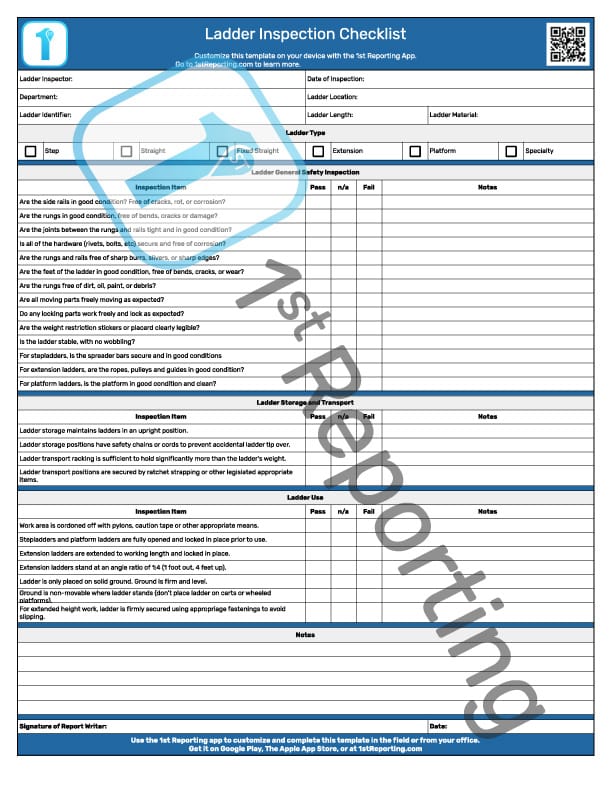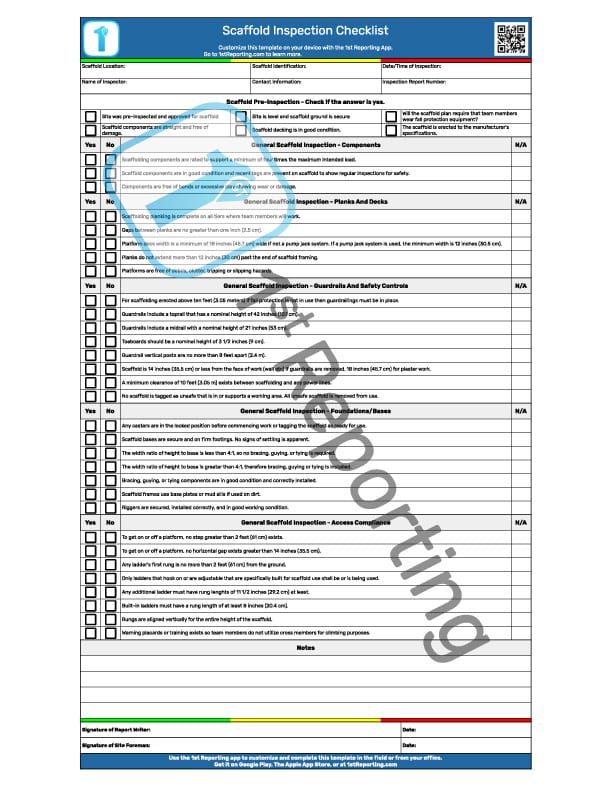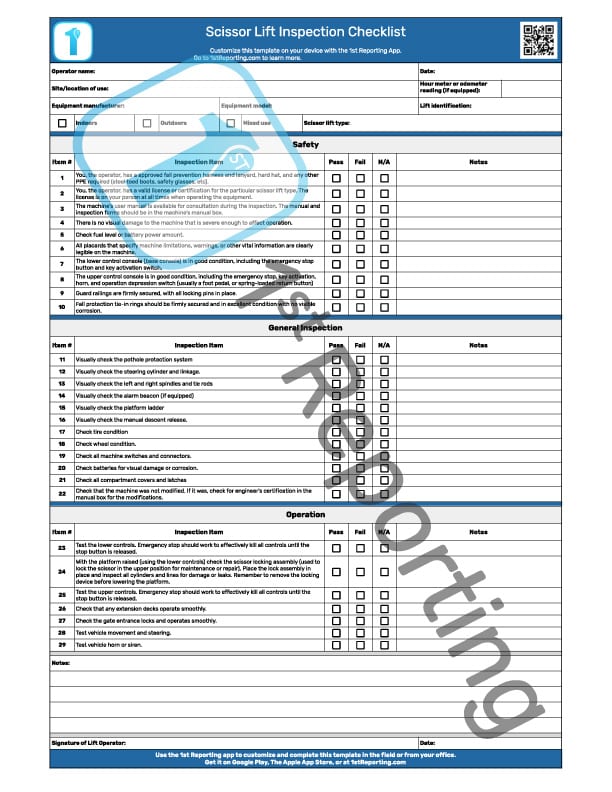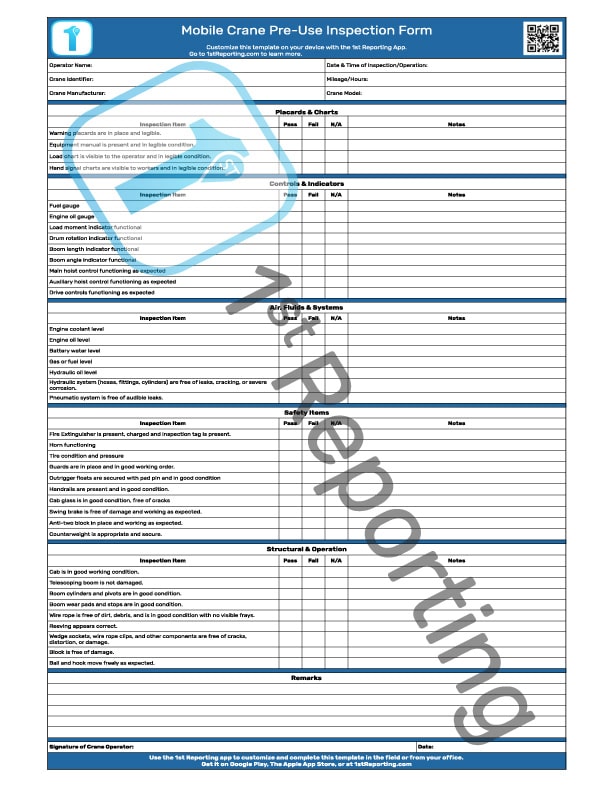If you need a safety harness daily inspection checklist, you’re in the right place. Maintaining safe operations when team members actively work at heights is a challenge and a necessity. We all want our teams to find a peaceful end of the day to go home to their families, so ensuring that everyone follows the strictest safety protocol is essential. Using our pre-formatted Fall Protection Safety Harness Daily Inspection Template is one way to ensure your team is striving to maintain daily safe operations.
We’ve created a free, versatile, and helpful downloadable template for your business team members to use with their fall protection equipment, mainly the harness and lanyard combination. Your team should use the inspection template daily before using the equipment.
Let’s take a quick walk-through of the template’s critical components. This will help you train your team to use the template efficiently and correctly.
Included In The Fall Protection Safety Harness Daily Inspection Template
Our inspection checklist template includes the ability for you and your team to inspect fall protection equipment, including belts, harnesses, regular lanyards, and retractable lanyards. To accommodate this safety inspection process, we’ve broken the template into six distinct and easy-to-follow sections:
- Administrative
- Type of Equipment
- Webbing Inspection
- Stitching Inspection
- Hardware Inspection
- Tag Inspection
- Notes and Signoff
We’ll briefly review each section to ensure your team members understand the concepts behind each section.
Administrative
Like any other inspection report or downloadable template, you must identify critical pieces of information about the who and what of the report topic. The administrative section of the Safety Harness Daily Inspection Template is simple: it’s a place to record the name of the equipment user/inspector and the date. Traditionally, the date on this report reflects the date of the inspection.
Type of Equipment
We’ve fabricated this downloadable template to function for several common-use types of fall protection personal protective equipment due to our commitment to standardization and efficiency. The types include belts, harnesses, and the two most common types of lanyards: standard and retractable.
Webbing Inspection
Most modern fall protection PPE is made of nylon strapping or webbing. This versatile webbing can be negatively affected by various types of damage and some types of chemicals. The webbing inspection section of the Safety Harness Daily Inspection Checklist includes the primary and typical issues to look for with the webbing condition on the fall protection equipment.
Stitching Inspection
Webbing wouldn’t do much good if manufacturers didn’t stitch it together. Due to the nature of stitching (literally holding things together), close attention must be paid when performing the stitching safety inspection. The stitching inspection section of the downloadable template has the specific things your team members need to look for and address.
Hardware Inspection
Hardware can make fall protection equipment more complicated for regular or daily safety inspections. Depending on the type and style of equipment, various technologies might be involved, and you need to understand how each works. For example, a retractable lanyard has a coil spring return system. There are multiple latches, from belt buckle style to friction crimping. Lastly, the lanyards will have various latches and tie-off clips, depending on the manufacturer.
Our Hardware Inspection section aims to take the guesswork out of the safety inspection of PPE by providing your team with the specific inspection points that they must consider.
Tag Inspection
The tag on fall protection equipment should state a manufacture date or date of equipment lifespan. The label should also include weight limitations and instructions for care.
Notes and Signoff
The final section of the downloadable template includes an area where the equipment user/inspector can relay further information. Following the notes section is a place for the inspector to sign and date the report, ensuring the quality of the result.
How To Use A Safety Harness Daily Inspection Report The Correct Way
The concept behind daily fall protection equipment inspections is that if we catch an issue before using safety equipment, we can prevent its failure in an emergency by removing it from service.
However, the real world isn’t quite this black and white. The idea that we rely on team members to comply with a thorough investigation of their safety equipment means that we depend on everyone to maintain a strict inspection process. Now, you and I both know that no one is perfect and unless you have a photographic memory, it isn’t out of the realm of possibility to forget something.
Similar to forgotten inspection items comes the real-world issue of complacency. Even the best team members who excel at their jobs might lose sight of or even bypass their daily equipment inspection elements. They might think things like, “My harness is fine; I just checked it yesterday.” This problem is one of the primary reasons we miss safety inspection elements—through assumption or poor memory recall.
The solution is a standardized checklist that team members must complete daily before using their safety equipment. The daily inspection and documentation process ensures that team members don’t skip or miss forgotten inspection points.
It also assures safety compliance if you implement a checkpoint whereby team members must hand in their daily inspections to a supervisor before beginning their workday. We’ll talk more later about some great solutions for this process control method. For now, let’s briefly discuss how to do a quick daily inspection and use the template to our advantage.
How do you inspect a safety harness?
A harness and lanyard safety inspection involves the use of three essential tools:
- Sight sense
- Touch sense
- Fall protection equipment inspection checklist
Your team will first visually inspect the equipment. The visual test is simple: either the harness or lanyard passes the qualifiers or it does not. There is no room for a grey area for safety equipment.
A visual inspection alone will not suffice to find potential webbing splits or cuts, and we need to incorporate a physical element into the assessment. The team members will touch their harnesses and lanyards, bending and moving them around while visually inspecting. Sometimes, a cut or frayed strap will not present the fray or cut until the webbing is stressed by bending, twisting, or pulling it. For this reason, the physical touch element of the safety inspection is critical.
Lastly, no inspection would be complete without documentation. That said, you should consider downloading our free template and printing it out for your team members’ use.
So, in a nutshell, to perform a harness or lanyard safety inspection, we look, touch, and record our findings.
But now your team may be asking you, ‘What do we look for, just cuts or frays?’. Well, there are unique criteria that you must consider when assessing a harness or lanyard for safe conditional use. According to OSHA, let’s next take a look at what some of the failure criteria are.
Automatic Fail Criteria
The following criteria will automatically fail a fall protection harness or lanyard during safety inspection:
- Webbing
- Cuts, tears, or nicks
- Broken fibers and frays
- Deteriorating or decaying fibers
- Modified, painted, or written on (most manufacturers don’t accept permanent markers on webbing as a safe practice)
- Uneven webbing thickness
- Severely discolored, shiny spots, or hard spots
- Cracking sound when flexing material
- Missing straps
- Burnt, melted, or charred strapping
- Stretched areas of webbing
- Stitching
- Missing stitching
- Cut or frayed stitching
- Pulled stitching
- Severe discoloration
- Hardware
- Bent or distorted components
- Bent or damaged grommets
- Rusted components
- User modified components
- Seized parts (tongue buckle roller, tongue)
- Cracked components
- Rough or sharp components
- Manufacturer Specification Tag
- Illegible
- Missing
- The date of equipment life expectancy is surpassed
How often should the safety harness be inspected?
Your team members should inspect safety equipment daily before use. If equipment is not used daily, a regularly scheduled inspection should take place to ensure you have the correct equipment on hand if needed. If the equipment is also inspected prior to use, you have a double checkpoint system to evade potentially using unsafe equipment.
How often should you inspect the lanyard?
A safety lanyard should fall under the same safety inspection process you have for your safety harness. In other words, the lanyard should be inspected simultaneously as the harness and just as frequently.
When should you inspect the safety harness?
We mentioned how often you should inspect a safety harness, but it’s worth noting that “when” is more essential than frequency. That is, the inspection should occur before using the equipment. There is little point in performing the inspection after the equipment is used, as the concept of the safety harness daily inspection is to catch issues before the equipment goes into use. Prevention doesn’t happen after the fact. It should have happened before.
Related Safety Harness Questions And Answers

How often should you replace the safety harness?
It would be best to replace the safety harness or lanyard when it fails a safety inspection. Using the key metrics of the safety inspection template, we can easily see the qualifying factors for the equipment to fail and require replacement.
What is the best way to inspect fall protection equipment?
The best way to inspect fall protection equipment is to use our 3-tier inspection rule:
- Look
- Touch
- Record
As mentioned above, using this three-step inspection technique for safety harnesses and lanyards will ensure that team members catch issues before using the equipment. However, how this inspection process is managed can make or break your safety inspection goals.
Managing A Robust Safety Harness Inspection Process
Some companies prefer to use a three-ring binder or similar book-like storage method, or even a filing cabinet, to maintain their safety records. Safety records should be kept on file for at least a year for companies to prove the due diligence of team members should an authority stop by to enforce regulations. Check with authorities in your area for the statute of time that you must maintain your safety records.
If keeping track of daily inspection paperwork sounds like a waste of time or a challenge you’d rather not add to your daily responsibilities, then we may have the perfect solution for you. It’s a mobile form automation application that streamlines and automates the process.
Consider this potential situation – A company has 20 service technicians who regularly work at heights, and each has fall protection equipment to inspect daily. Now, the supervisor of the said team could try to chase down each service technician prior to beginning their day in order to ascertain if they have complied with safety regulations or not. But, wouldn’t it be better to be efficient so the technicians can get out to their job sites to earn the company money? And don’t we want to do this process as efficiently as possible?
Cloud-Based Solutions
Enter the cloud-based reporting solutions like the 1st Reporting app available on Google Play and The Apple App Store. This customizable inspection and reporting software would allow you to create a customized checklist or template from scratch. You can also use one of our pre-built template solutions.
Your team members could access the safety inspection form on their smart device (smartphone, tablet, laptop, or computer) and complete the form right from their service truck, office, or even remote job site.
Once your team submits the form, you can get an instant notification sent to whomever supervisor you want to oversee that staff has completed their daily safety checks.
You could even create a supervisor template for your supervisor to complete that notifies you that the supervisor has checked that all staff has complied. This type of form automation not only saves you time and money from having to pay labor rates to someone to collect, organize, and file forms, but it also saves time with data retrieval.
In fact, you can access any of the submitted inspection forms from any location as long as you have a device to access the cloud-based secure database. With such efficient, time-saving technology, it’s a wonder why every business isn’t using systems like the 1st Reporting app already.







